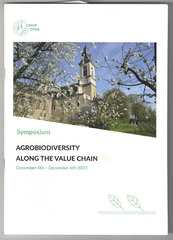Приказ основних података о документу
Exploitation of genetic diversity of spring hull-less barley in a field trial in Serbia
| dc.creator | Brbaklić, Ljiljana | |
| dc.creator | Jevtić, Radivoje | |
| dc.creator | Župunski, Vesna | |
| dc.creator | Boerner, Andreas | |
| dc.creator | Mikić, Sanja | |
| dc.creator | Timić, Jovana | |
| dc.creator | Mirkov Knežević, Svetlana | |
| dc.date.accessioned | 2023-12-14T19:02:41Z | |
| dc.date.available | 2023-12-14T19:02:41Z | |
| dc.date.issued | 2023 | |
| dc.identifier.uri | http://fiver.ifvcns.rs/handle/123456789/4132 | |
| dc.description.abstract | Hull-less barley is an underutilized crop, mostly used for human consumption, representing less than 2% of the entire barley production in both Europe and Serbia. CROPDIVA's priority is to select and improve of hull-less barley breeding for many important characteristics related to yield and quality. The consumption of naked barley has significant positive effects on human health. A total of 360 spring naked barley genotypes was used to evaluate genetic variability. This panel comprised of 300 diverse accessions from IPK genebank collection and 10 standards representing commercial and well-adapted cultivars from the United Kingdom, Switzerland, Germany, and Serbia. The trial was conducted at Rimski sancevi (N45°19" E 19°50') in Serbia, following soybean as the previous crop. The size of micro plots was 1 m2 setup in an augmented block design using 10 standards in six repetitions. The sowing time was on 10th March using standard agronomic practices. During the season, the following traits were measured: date ofemergence, canopy size using Canopeo application during growth and developmental phases (G511,GS31, GS59), heading time, straw length, lodging, and yield. After harvesting season, we will beginmeasuring yield component traits and quality parameters such as: total biomass, spike number, grain weight, thousand grain weight, grains per spike, harvest index, specific weight, grain colour — staining, treshability, beta-glucan, and nitrogen content. Canopeo values in GS11 (first leaf unfolded - ligule visible), in GS31 (first node detectable) and in GS59 (ear completely emerged above flag leaf ligule) growth stages ranged from 0.48 to 4.99, from 25.7 to 82.02 and 10.95 and 94.01, respectively. Heading day occurred within 23 days’ time window, from 17 May to 10 June. The average straw length was 66 cm, varied from to 30 cm to 95 cm. Approximately one third of the accessions was prone to lodging. Preliminary results have shown that the selected IPK collection possesses significant diversity which canserve as a good basis in a further hull-less breeding program. | sr |
| dc.language.iso | en | sr |
| dc.relation | info:eu-repo/grantAgreement/EC/RIA/101000847/EU// | sr |
| dc.rights | openAccess | sr |
| dc.rights.uri | https://creativecommons.org/licenses/by/4.0/ | |
| dc.source | Abstracts, 1st CROPDIVA International Symposium “Agrobiodiversity Along the Value Chain”, Ghent, 4-6 December 2023 | sr |
| dc.subject | barley | sr |
| dc.subject | cultivars | sr |
| dc.subject | yield | sr |
| dc.subject | genetic diversity | sr |
| dc.subject | hull-less barley | sr |
| dc.subject | cultivars | sr |
| dc.subject | Serbia | sr |
| dc.title | Exploitation of genetic diversity of spring hull-less barley in a field trial in Serbia | sr |
| dc.type | conferenceObject | sr |
| dc.rights.license | BY | sr |
| dc.citation.epage | 58 | |
| dc.citation.spage | 58 | |
| dc.identifier.fulltext | http://fiver.ifvcns.rs/bitstream/id/9901/LjB_Cropdiva.pdf | |
| dc.identifier.rcub | https://hdl.handle.net/21.15107/rcub_fiver_4132 | |
| dc.type.version | publishedVersion | sr |


